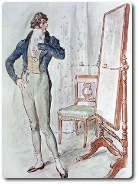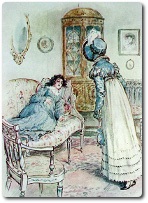Persuasion Contents
Objects
The physical environment
Jane Austen does not give many physical details in her novels, and when she mentions an object it is there for a reason, and usually has a specific function. In Persuasion, an object is often placed so that it is in proximity to a single character, and tells us something about them, or it may occupy the same space as several characters and tell us something about their relationship with one another.
Mirrors
 In Jane Austen's day, mirrors were expensive and an indicator of wealth. In Persuasion they are used to develop the theme of vanity:
In Jane Austen's day, mirrors were expensive and an indicator of wealth. In Persuasion they are used to develop the theme of vanity:
- The mirrors which Sir Walter has scattered throughout Kellynch and Camden Place are emblematic of his narcissism. He enjoys the reflection of his personal appearance and status that they give him. Ironically, he no longer has the fortune they suggest
- Just as Sir Walter refuses to reflect on the fact that his appearance is not what it used to be, so he refuses to reflect on his character flaws
- The mirrors only reflect a superficial image with no substance behind it, echoing Sir Walter's lack of depth
- Elizabeth functions as Sir Walter's mirror-image. She shares the same preoccupation with status and is equally selfish and vain
- Anne's appearance is ‘totally different' from her father's and so are her values. He has no esteem for her because he does not see himself reflected in her
- Admiral Croft is uncomfortable with the mirrors at Kellynch as ‘there is no getting away from oneself'. His view is representative of the navy and is not self-focused, but looking outward to the interests of others.
Investigating the mirror motif
- Can you point to ways in which the novel is structured to be reflective?
- When and why does that reflection become an inverted one?
Sofas
 The sofa was in vogue in Jane Austen's day, and was used for reclining. J.E. Austen-Leigh mentions in his Memoir that Jane Austen avoided using the only sofa at Chawton Cottage, perhaps because of its associations with self-indulgence and laziness. Instead, when she was ill she lay on a makeshift couch made of three chairs pushed together. In Persuasion the sofa appears on several occasions that recall Jane Austen's dislike of them:
The sofa was in vogue in Jane Austen's day, and was used for reclining. J.E. Austen-Leigh mentions in his Memoir that Jane Austen avoided using the only sofa at Chawton Cottage, perhaps because of its associations with self-indulgence and laziness. Instead, when she was ill she lay on a makeshift couch made of three chairs pushed together. In Persuasion the sofa appears on several occasions that recall Jane Austen's dislike of them:
- When Anne goes to Uppercross to take care of Mary, Mary's dissatisfaction and boredom are emphasised by her prone position on the sofa (Ch. 5)
- Mary's sofa is faded and her furniture is described as ‘once elegant', rather like the landed gentry she represents whose usefulness has faded and whose elegance has no purpose
- The acute discomfort that Anne and Captain Wentworth experience in their physical proximity to one another is accentuated as they sit on the sofa separated only by Mrs. Musgrove (Ch. 8)
- Little Charles lies on a sofa and Anne is tending to him there when Walter climbs on her and Wentworth comes to the rescue. There is a charged physicality and intimacy to the scene (Ch. 9).
Recently Viewed
-
Persuasion » Objects
now -
Persuasion » Money
just now
Scan and go

Scan on your mobile for direct link.